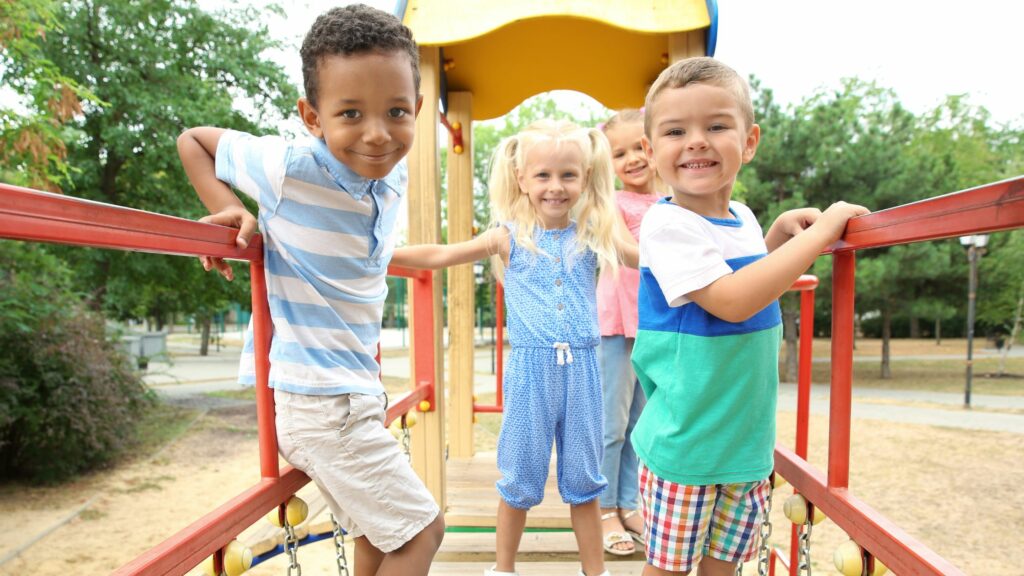Have you ever heard of the term “risky play”? Many people may have a misconception of what it entails. You may think that it’s not safe; or maybe even let’s avoid it! Exploration and learning inevitably can lead to some moments of play that may cause you to feel a little uncomfortable. Has your child ever engaged in an activity or movement that made you feel nervous, anxious, and unsure of your child’s safety? Examples of risky play might include climbing a tree, wrestling, running down a hill, using tools, climbing on furniture or play structures, hanging upside down, and jumping down from high places. Risky play is thrilling, challenging, or exciting play with unknowns, and the potential of getting hurt or lost. Research advocates for reasonable and age-appropriate risky play to help children learn to assess risk and safety, understand limits, develop self reliance, resilience, and confidence.
Play is essential for children and their overall development, especially outdoor play. When children combine outdoor play with risky play, there are numerous benefits. The risky play movements and activities are essential for motor skill development, balance, coordination, body awareness, and regulation. Children need risky play so they feel comfortable moving their own bodies confidently in the environment. Every child engages in risky play differently. At Rising Stride we encourage children to make safe decisions about how to move their bodies in the environment and provide guidance as needed depending on the level of risk. Some strategies that parents and caregivers can utilize for risky play include: removing hazards, explaining safety rules without making them sound scary, and allowing reasonable, supervised risks when children feel ready.
WHAT IS RISKY PLAY?
Risky play is unstructured play that is thrilling and exciting. It gives that tickle feeling in the stomach. It lets the child freely explore their personal boundaries with fear and risk. Therefore, each child’s risky play will look different.
Risky play will also look different at the various developmental levels. It is important to let the child have enough mental and physical space to determine what is appropriate risk for themselves. It should be exhilarating, but not too scary.
It always makes me think about kids on a playground. Some are climbing all over, even on the outside of the play equipment. Others are too scared to go up the ladder or go down the slide. Some children find it exhilarating to watch other children take risks. Each is engaging in their amount of appropriate risk.
Once upon a time, what we now call ‘risky play’ was just called play.
Things like:
-
Climbing trees
-
Rolling down steep hills
-
Swinging as high as possible on a swing or rope
-
Hanging upside down
-
Balancing at heights
-
Throwing rocks
-
Playing with tools that could cut and pierce
-
Spinning around as fast as possible just to see how dizzy you could get
-
Playing with fire
-
Playing hide and seek over large areas
To protect our children we must allow them to play in ways deemed “risky.”
-Peter Gray Ph.D. author of Free to Learn
Below are 6 Categories of Risky Play:
Exploring height:
This is often done by climbing trees. Climbing trees requires motor skills, problem-solving, patience, judgment, and persistence. Whether it’s a child climbing to the top, or one who is happy to hang from a branch with their feet inches from the ground, the thrill is theirs.
Moving:
The most important thing you can do is give children the time, space, and opportunity to move. Students learn to regulate how much force is needed to complete a task. Children learn to regulate their body’s force by playing tag without hurting another child or holding something fragile with appropriate gentleness -working outdoors, such as digging in the dirt, or pulling a wagon with heavy rocks or pails filled with stones or shells, activates this sense. Quick movement, running, jumping, and hopping are important ways children build confidence in themselves and their abilities.
Tool Play:
Children can learn about cause and effect through risky play experiences by observing the tools’ impact on particular materials. This will support their problem-solving and logical thinking while offering a real-life experience.
Exploring Elements:
Allowing children to explore natural elements is a vital part of development. Children are increasingly more fascinated by things they are unable to explore. Providing a safe space for children to explore fire, water, and any other risky element is beneficial for children to respect them and grow as advocates for safety in the future.
Rough and Tumble:
Rough-and-tumble play (RTP) is a common form of play between children. RTP can contribute to the development of self-regulating, acknowledgment of boundaries, and consent.
Exploration:
Exploring the inside and outside world is essential for children’s emotional, social, and physical development. It also gives children a chance to work on necessary motor skills. Allowing children to understand outcomes is also a massive benefit of exploration.
Risky play is essential to growing happy, grounded, and emotionally intelligent kids:
When kids are allowed to play with risk, they experience manageable levels of fear and have the chance to practice holding themselves through this emotion. Similarly, while engaging in rough and tumble play, children might experience anger if one person accidentally hurts another. But as Peter Gray says, to continue playing, to continue the fun, they must overcome that anger. If they lash out, the play is over. In this simulated play, they can overcome negative emotions and learn to manage their feelings in close quarters with other people.
What this all means is that children are building up essential survival skills that positively influence their ability to cope in demanding or dangerous situations.
While this is not something we would ever want our children to encounter, we must return to the main point here – PROTECTING THEM FROM RISK IS NOT PROTECTING THEM FROM DANGER.
Letting children experience risky play sets them up with the skills and confidence to face real dangers and real challenges when they occur. Because let’s face it, we can’t be there to protect our children at every turn. What we can do is prepare them as best we can to respond to life’s ups and downs with the ability to emotionally self-regulate.

